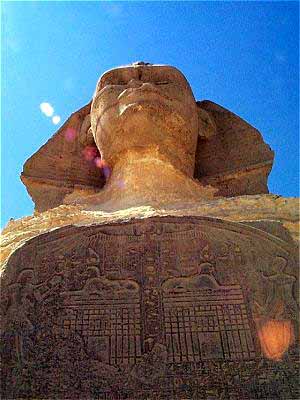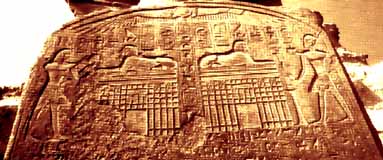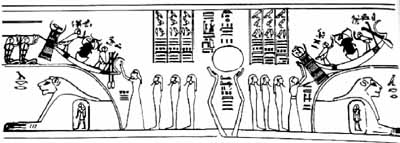Home Page
 Applying Cayce Medicine
Applying Cayce Medicine
Receive our newest Pathways to Health newsletter. Become a member of the A.R.E. Clinic's
Healing Circle!
Articles from July/August 1999:
The Riddle of the Second Sphinx, by Scott Grady, CHt
Cayce’s Insights Link Ear Infection with Anemia, by Debra Anastasio
The Healing Nature of Watermelon Seed Tea, by Ellen Satinsky, NMD
True Healing of the Body, by William A. McGarey, MD
The Radio-Active Appliance: Attunement for Body, Mind, & Spirit, by Scott Grady, CHt
|
|

|
 Between the paws of the Sphinx lies a tablet (or stele) that shows two figures giving offerings to two Sphinxes. Could this indicate the presence of a second Sphinx as yet uncovered?
Between the paws of the Sphinx lies a tablet (or stele) that shows two figures giving offerings to two Sphinxes. Could this indicate the presence of a second Sphinx as yet uncovered?
|
Phenomena
The Riddle of the Second Sphinx
by Scott Grady, CHt
Research & Education, A.R.E. Clinic
Professional archaeologists in Egypt have been both amused and alarmed by the strange, radical, and exotic ideas circulating about Egypt, the Great Pyramid, and the Sphinx.
One of those strange, radical ideas is that offered by Edgar Cayce in his psychic readings. In them he indicates that the Great Pyramid and Sphinx were built in 10,500 BC, around the time of the sinking of Atlantis. He said they were made by a people from the Caucasus mountains who favored the symbol of the lion. Amateur Egyptologists Robert Bauval and Graham Hancock have published books that help to confirm Cayce’s date of 10,500 BC through a method called archaeo-astronomy. They think the Sphinx was made in the shape of a lion to commemorate, in stone, the year of 10,500 BC, a time when the constellation of Leo arose from the horizon at the first dawn of spring.
Another exotic idea is that there may actually be a second Sphinx. While this idea has been considered by others, amateur Egyptologist
Bassam El Shammaa has drawn attention to the possibility that there may be an additional large Sphinx directly to the south, facing to the east and the Nile just like its famous brother. His rationale is based upon the Egyptian tradition of always placing sphinx statues in pairs, as guardians for temples. Also, nestled between the paws of the Sphinx is a stele — a carved slab of stone — that tells a story in which two Sphinxes are depicted side by side. El Shamma suggests that we should take this image literally, whereas conventional archaeologists believe that the two Sphinxes are just a repeated image of the same Sphinx.
El Shamma makes a good case, and it will be interesting to see if there is indeed a second Sphinx to the south of the present one. But while Cayce never spoke of a second Sphinx, he did make a puzzling remark that might indicate a Sphinx at Giza that is facing to the west. In giving the instructions for an “aura chart,” a pictorial representation of a person’s journey through many lifetimes, he gave the artist the following directions.
|
 This detailed photograph of the stele depicts two Sphinxes, each upon
similar temple-like bases. Are these representing the same monument,
or are there actually two Sphinxes?
This detailed photograph of the stele depicts two Sphinxes, each upon
similar temple-like bases. Are these representing the same monument,
or are there actually two Sphinxes?
|
“The symbols or signs above this, while not the central figure in the chart, would be a rather broad landscape; indicating at least three pyramids in the distance, with the Sphinx which — to be sure — would FACE the central or larger figure of the pyramid.” [307–20]
In other readings regarding the Sphinx, there is no confusion. Cayce clearly indicates that in the other readings he is talking about a Sphinx that faces the east, with the Great Pyramid on its left rear flank.
But if a Sphinx were to face the central pyramid, as was just indicated by Cayce, then it would be facing west. One might imagine that the first Sphinx faces the east, and a second Sphinx faces the west, the two of them laid out tail to tail in a line. Interestingly enough, this is exactly what is depicted on the stele between the paws of the Sphinx. It shows two Sphinxes, back to back, and if one faces east, then one must be facing west.
This idea of two Sphinxes — however radical it may seem — is well represented in Egyptian iconography. The high god of the sun, Atum, created Shu and Tefnut in the form of two lion cubs. When the sun sets, the western lion is said to take the sun in its jaws and carry it through the underworld, passing it to the eastern lion. Thus after a period of darkness begins the sunrise.
These two lions symbolize “yesterday” and “tomorrow,” and they are used in hieroglyphics to indicate the horizon, and the solar disk of the god is raised between them. These lions were responsible for guarding the eastern and western boundaries, and they supported the Light against the Dark.
|
 The lions of yesterday and tomorrow, and the circle of the
great god Atum between them.
The lions of yesterday and tomorrow, and the circle of the
great god Atum between them.
|
Other ancient Egyptian writings refer to the Sphinx as the “Horus on the horizon.” This might help to indicate that this eastward-facing lion, the Sphinx, is intended to be a protector from the forces of darkness, because Horus was the champion of the Light, who defeated Seth, the lord of the underworld.
But where is the western-facing companion to the eastern Sphinx? If there is a western companion, it lies undetected in the high plateau between the Sphinx and the pyramid of Khafra, the central pyramid. (See
Interactive view of the Sphinx and Pyramids of the Giza Plateau.)
One final note on this controversial subject: Cayce referred to the Giza complex — particularly the Great Pyramid — as a prophecy in stone. It was to depict the period between the ending of one kind of earthly existence and the beginning of a new one. In essence, it marked the time between the ending of the old world of Atlantis, and the beginning of a new world, a new spiritual understanding, which apparently is starting right now. One reading says, “The old record in Gizeh is from that as recorded from the journey to Pyrenees; and to 1998 from the death of the Son of Man (as a man).” [378–14] It seems that the cosmic clock of Giza runs till 1998, then ends.
This is difficult to understand, even with the aid of the Cayce readings. But one interesting fact shines through, brought up by the notion of a second Sphinx. If there was a second Sphinx, looking into the western skies, then as we enter into the age of Aquarius, it would witness the passing of the contellation of Leo into the underworld. It would see the sign that was there in its beginnings fall away, beyond the horizon, upon the very first dawn of spring in our new age.
|
|

